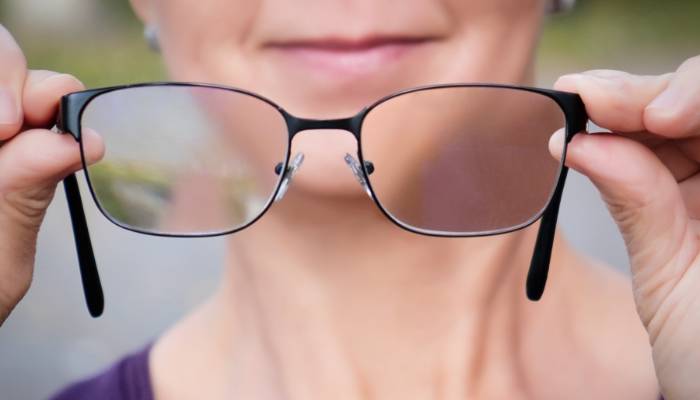
Progressive lenses, also known as multifocal lenses, are eyeglass lenses that provide a gradual transition between different prescriptions. Unlike bifocal lenses, which have a visible line separating the different prescriptions, these lenses have a seamless transition from distance vision to near vision.
Knowing, how to get used to progressive lenses i.e. adapting to these lenses is essential for individuals who need different prescriptions for different activities, such as reading, driving, or using a computer.
Progressive lenses offer a convenient way to see clearly at different distances without having to switch between different pairs of glasses. The benefits of using these lenses include improved vision and convenience, as well as the ability to reduce the number of glasses an individual needs to carry around.
Understanding Progressive Lenses
How Multi-focal Lenses Work
Lenses of progressive type work by gradually changing the prescription from the top of the lens to the bottom. This allows the wearer to see clearly at different distances without the need to switch between different pairs of glasses.
Types of Progressive Lenses
There are two main types of progressive lenses [1]: standard and customized. Standard lenses of progressive type are mass-produced and provide a good fit for most people. Customized multi-focal lenses are made to order and are designed to meet the specific needs of the wearer.
Progressive Lenses and Bifocal Lenses : Differences
The lenses of progressive type differ from bifocal lenses in that they provide a seamless transition between different prescriptions. Bifocal lenses have a visible line separating the different prescriptions.

Getting Used to Progressive Lenses
Common Problems Experienced
Adjusting to multi-focal lenses can take some time and effort. Common problems experienced when adapting to these lenses include eye strain, blurry vision, headaches, nausea, and dizziness.
Tips for Adjusting
To adjust to these lenses, it is important to wear them regularly and follow these tips:
Wear Your Progressive Lenses Regularly
Wearing your lenses of progressive type regularly will help you get used to them more quickly. It is essential to wear them for a few hours each day until your eyes become accustomed to them.
Keep Your Head Still and Move Your Eyes
To avoid blurry vision and dizziness, it is important to keep your head still and move your eyes when looking at different distances.
Find the Right Frame
Finding he right frame can make a big difference in how well you adapt to your progressive lenses. Look for a frame that fits well and has a comfortable nose pad and temple arms.
Visit Your Eye Doctor Regularly
Regular visits to your eye doctor will help ensure that your prescription is up to date and that your progressive lenses are working properly.
The Timeframe for Adapting to Lenses of Progressive Type
The timeframe for adapting to progressive lenses can vary from person to person. There are two main periods of adaptation:
Initial Adaptation Period
The initial adaptation period typically lasts for a few days to a week. During this time, you may experience some discomfort, such as eye strain, blurry vision, or headaches. It is essential to wear your progressive lenses regularly during this time to help your eyes adjust.
Continued Adaptation Period
The continued adaptation period can last up to a few weeks or even a few months. During this time, your eyes will continue to adjust to your progressive lenses. It is important to continue wearing your lenses regularly and to visit your eye doctor if you experience any persistent problems.
Getting Used to Progressive Lenses
The right frame can make a big difference in how well you adapt to your progressive lenses. Look for a frame that fits well and has a comfortable nose pad and temple arms.
Visit Your Eye Doctor Regularly
Regular visits to your eye doctor will help ensure that your prescription is up to date and that your progressive lenses are working properly.
Troubleshooting Common Problems
- Eye Strain: If you experience eye strain when wearing your progressive lenses, take a break and rest your eyes. It may also help to adjust the positioning of your glasses on your nose or to adjust the lighting in your environment.
- Blurry Vision: If you experience blurry vision when wearing your progressive lenses, try moving your eyes instead of your head to look at different distances. You can also try adjusting the position of your glasses on your nose or visiting your eye doctor to see if your prescription needs to be adjusted.
- Headaches: If you experience headaches when wearing your progressive lenses, take a break and rest your eyes. You may also need to adjust the position of your glasses on your nose or visit your eye doctor to see if your prescription needs to be adjusted.
- Nausea and Dizziness: If you experience nausea or dizziness when wearing your progressive lenses, take a break and rest your eyes. It may also help to adjust the positioning of your glasses on your nose or to adjust the lighting in your environment.
- Other Problems: If you experience any other problems when wearing such lenses, such as discomfort or difficulty seeing, visit your eye doctor to see if your prescription needs to be adjusted or if there is another underlying issue.
Wear them regularly
Adapting to progressive lenses is important for individuals who need different prescriptions for different activities. These lenses offer a convenient way to see clearly at different distances without having to switch between different pairs of glasses. To adjust to these lenses, it is important to wear them regularly, keep your head still and move your eyes, find the right frame, and visit your eye doctor regularly.
Final Thoughts
While learning how to get used to progressive lenses can take some time and effort, the benefits of improved vision and convenience make it well worth the effort. With patience and persistence, most individuals can successfully adjust to their lenses and enjoy clear vision at all distances.

Lifebing is driven by an unrelenting passion for promoting health and well-being, our team is wholly committed to curating exceptional content and immersive experiences.
